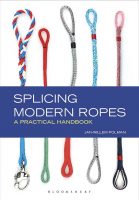Find out how to thicken and strengthen ropes in this extract from Splicing Modern Ropes, by Jan-Willem Polman
When ropes slip in a clutch you can thicken them locally by splicing an extra cover or core into them. To thicken a rope for a clutch, use a polyester or non-slip fibre cover; a cover of pure Dyneema would be too slippery.
Similarly, an extra cover can be used to protect a rope from wear at critical points; use a Dyneema cover for this because it is very durable.
One example is the point at which the spinnaker halyard moves back and forth through the sheave or block at the masthead.
Ever wondered how to make rope? Check out this video of a traditional ropewalk device
Splicing in an extra cover

1. Feed the rope through the extra cover with a fid. Leave some spare room on each side.

2: Move the cover over the area you want to thicken or protect.

3: Pull the extra cover through the rope cover with a pulling needle so that it can be buried completely.

4: Add a double-stitched whipping over the transition and cut the end of the extra cover diagonally

5: Slide the rope back. Repeat the previous steps on the other side.

6: This creates a rope with an extra cover spliced in.
Sewing in an extra cover
If you’d like a smoother transition that doesn’t require whipping, sew in the extra cover. This is also useful where the rope is braided very tightly. Although it is not very difficult, it is a lot of work.

1: Feed the rope through the extra cover with a fid.

2: Slide the cover over the area you want to thicken or protect.

3: Tape the extra cover about 15-20cm from its tail.

4: Unlay the extra cover and, one by one, sew the strands through the rope using a zigzag stitch.

5: Ensure an even spread by varying where you finish stitching the strands.

6: Repeat at the other end. This creates a rope with an extra cover sewn in.
Splicing in an extra core
If your rope won’t hold in your clutch, or if you want to thicken it for any other reason, you can splice in an extra core.

1: Take the core from the cover at the point from where you want to splice in the extra core.

2: Pull the extra core into the rope core with a fid or a pulling needle, depending on the length.

3: Milk the core back from the centre.

4: Taper the ends of the extra core.

5: Milk the new core back from the centre…… then milk the original cover back over the thickened core.

6: This creates a rope with an extra core spliced in.
 This is extracted from Splicing Modern Ropes, by Jan-Willem Polman, published by Bloomsbury.
This is extracted from Splicing Modern Ropes, by Jan-Willem Polman, published by Bloomsbury.





